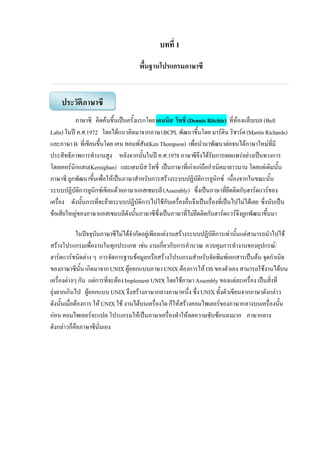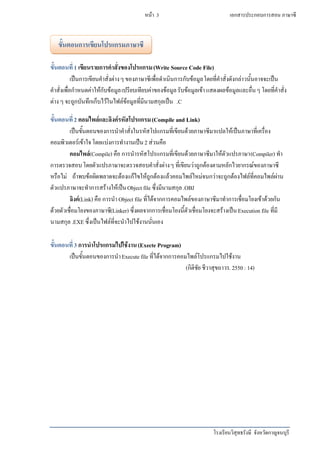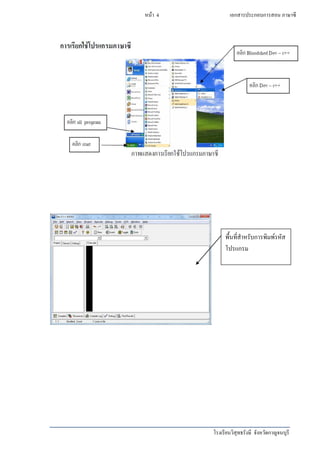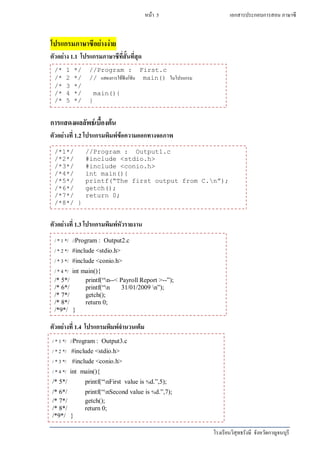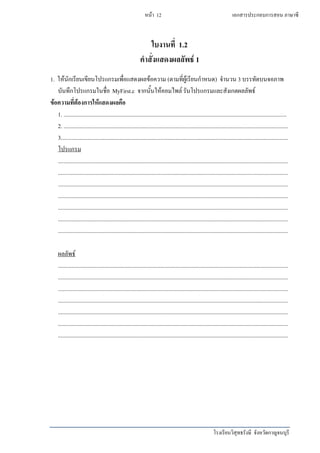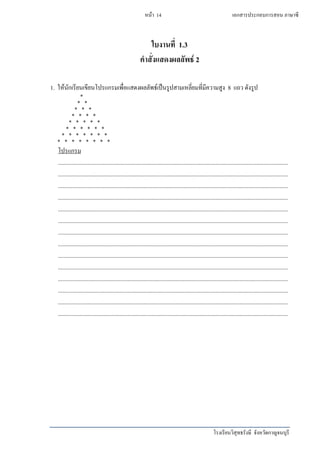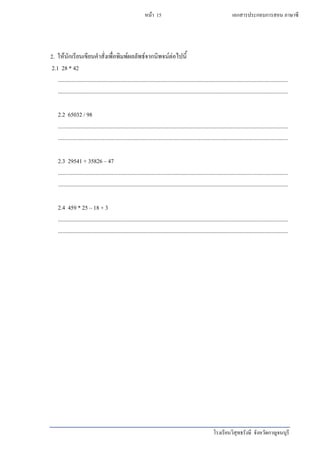аёҡаё—аё—аёөа№Ҳ1 аёһаё·а№үаёҷаёҗаёІаёҷа№ӮаёӣаёЈа№ҒаёҒаёЈаёЎаё аёІаё©аёІаёӢаёө
- 1. аёҡаё—аё—аёөа№Ҳ 1 аёһаё·а№үаёҷаёҗаёІаёҷа№ӮаёӣаёЈа№ҒаёҒаёЈаёЎаё аёІаё©аёІаёӢаёө аё аёІаё©аёІаёӢаёө аё„аёҙаё”аё„а№үаёҷаёӮаё¶а№үаёҷа№Җаёӣа№Үаёҷаё„аёЈаёұа№үаёҮа№ҒаёЈаёҒа№Ӯаё”аёўа№Җаё”аёҷаёҷаёҙаёӘ аёЈаёҙаё—аёҠаёөа№Ҳ (Dennis Ritchie) аё—аёөа№Ҳаё«а№үаёӯаёҮа№ҒаёҘа№Үаёҡа№ҖаёҡаёҘ (Bell Labs) а№ғаёҷаёӣаёө аё„.аёЁ.1972 а№Ӯดยไดа№үа№Ғаёҷаё§аё„аёҙаё”аёЎаёІаёҲаёІаёҒаё аёІаё©аёІBCPL аёһаёұаё’аёҷаёІаёӮаё¶а№үаёҷа№Ӯаё”аёў аёЎаёІаёЈа№Ңаё•аёҙаёҷ аёЈаёҙаёҠаёІаёЈа№Ңаё”(Martin Richards) а№ҒаёҘаё°аё аёІаё©аёІ B аё—аёөа№Ҳа№ҖаёӮаёөаёўаёҷаёӮаё¶а№үаёҷа№Ӯаё”аёў а№Җаё„аёҷ аё—аёӯаёЎаёһа№ҢаёӘаёұаёҷ(KenThompson) а№Җаёһаё·а№ҲаёӯаёҷаёІаёЎаёІаёһаёұаё’аёҷаёІаё•а№ҲаёӯаёҲаёҷไดа№үаё аёІаё©аёІа№ғаё«аёЎа№Ҳаё—аёөа№ҲаёЎаёө аёӣаёЈаё°аёӘаёҙаё—аёҳаёҙаё аёІаёһаёҒаёІаёЈаё—аёІаёҮаёІаёҷаёӘаё№аёҮ аё«аёҘаёұаёҮаёҲаёІаёҒаёҷаёұа№үаёҷа№ғаёҷаёӣаёө аё„.аёЁ.1978 аё аёІаё©аёІаёӢаёөаёҲаё¶аёҮไดа№үаёЈаёұаёҡаёҒаёІаёЈа№Җаёңаёўа№ҒаёһаёЈа№Ҳаёӯаёўа№ҲаёІаёҮа№Җаёӣа№Үаёҷаё—аёІаёҮаёҒаёІаёЈ а№Ӯаё”аёўа№Җаё„аёӯаёЈа№ҢаёҷаёҙаёҒа№Ғаё®аёҷ(Kernighan) а№ҒаёҘаё°а№Җаё”аёҷаёҷаёҙаёӘ аёЈаёҙаё—аёҠаёөа№Ҳ а№Җаёӣа№Үаёҷаё аёІаё©аёІаё—аёөа№Ҳа№ҖаёҒа№ҲаёІа№ҒаёҒа№Ҳаё–аё·аёӯаёҒаёІа№Җаёҷаёҙаё”аёЎаёІаёўаёІаё§аёҷаёІаёҷ а№Ӯаё”аёўа№Ғаё•а№Ҳа№Җаё”аёҙаёЎаёҷаёұа№үаёҷ аё аёІаё©аёІаёӢаёө аё–аё№аёҒаёһаёұаё’аёҷаёІаёӮаё¶а№үаёҷа№Җаёһаё·а№Ҳаёӯа№ғаё«а№үа№Җаёӣа№Үаёҷаё аёІаё©аёІаёӘаёІаё«аёЈаёұаёҡаёҒаёІаёЈаёӘаёЈа№үаёІаёҮаёЈаё°аёҡаёҡаёӣаёҸаёҙаёҡаёұаё•аёҙаёҒаёІаёЈаёўаё№аёҷаёҙаёҒаёӢа№Ң а№Җаёҷаё·а№ҲаёӯаёҮаёҲаёІаёҒа№ғаёҷаёӮаё“аё°аёҷаёұа№үаёҷ аёЈаё°аёҡаёҡаёӣаёҸаёҙаёҡаёұаё•аёҙаёҒаёІаёЈаёўаё№аёҷаёҙаёҒаёӢа№Ңа№ҖаёӮаёөаёўаёҷаё”а№үаё§аёўаё аёІаё©аёІа№ҒаёӯаёӘа№ҖаёӢаёЎаёҡаёҘаёө(Assembly) аёӢаё¶а№ҲаёҮа№Җаёӣа№Үаёҷаё аёІаё©аёІаё—аёөа№Ҳаёўаё¶аё”аё•аёҙаё”аёҒаёұаёҡаё®аёІаёЈа№Ңаё”а№Ғаё§аёЈа№ҢаёӮаёӯаёҮ а№Җаё„аёЈаё·а№ҲаёӯаёҮ аё”аёұаёҮаёҷаёұа№үаёҷаёҒаёІаёЈаё—аёөа№ҲаёҲаё°аёўа№үаёІаёўаёЈаё°аёҡаёҡаёӣаёҸаёҙаёҡаёұаё•аёҙаёҒารไаёӣа№ғаёҠа№үаёҒаёұаёҡа№Җаё„аёЈаё·а№ҲаёӯаёҮаёӯаё·а№ҲаёҷаёҲаё¶аёҮа№Җаёӣа№Үаёҷа№ҖаёЈаё·а№ҲаёӯаёҮаё—аёөа№Ҳа№Җаёӣа№Үаёҷไаёӣไมа№Ҳไดа№үа№ҖаёҘаёў аёӢаё¶а№ҲаёҮаёҷаёұаёҡа№Җаёӣа№Үаёҷ аёӮа№үаёӯа№ҖаёӘаёөаёўа№ғаё«аёҚа№ҲаёӮаёӯаёҮаё аёІаё©аёІа№ҒаёӯаёӘа№ҖаёӢаёЎаёҡаёҘаёөаё”аёұаёҮаёҷаёұа№үаёҷаё аёІаё©аёІаёӢаёөаёӢаё¶а№ҲаёҮа№Җаёӣа№Үаёҷаё аёІаё©аёІаё—аёөа№Ҳไมа№Ҳаёўаё¶аё”аё•аёҙаё”аёҒаёұаёҡаё®аёІаёЈа№Ңаё”а№Ғаё§аёЈа№ҢаёҲаё¶аёҮаё–аё№аёҒаёһаёұаё’аёҷаёІаёӮаё¶а№үаёҷаёЎаёІ а№ғаёҷаёӣаёұаёҲаёҲаёёаёҡаёұаёҷаё аёІаё©аёІаёӢаёөไมа№Ҳไดа№үаёҲаёІаёҒаёұаё”аёӯаёўаё№а№Ҳа№ҖаёһаёөаёўаёҮа№Ғаё„а№ҲаёҮаёІаёҷаёӘаёЈа№үаёІаёҮаёЈаё°аёҡаёҡаёӣаёҸаёҙаёҡаёұаё•аёҙаёҒаёІаёЈа№Җаё—а№ҲаёІаёҷаёұа№үаёҷа№Ғаё•а№ҲаёӘаёІаёЎаёІаёЈаё–аёҷาไаёӣа№ғаёҠа№ү аёӘаёЈа№үаёІаёҮа№ӮаёӣаёЈа№ҒаёҒаёЈаёЎа№Җаёһаё·а№ҲаёӯаёҮаёІаёҷа№ғаёҷаё—аёёаёҒаёӣаёЈаё°а№Җаё аё— а№ҖаёҠа№Ҳаёҷ аёҮаёІаёҷа№ҖаёҒаёөа№Ҳаёўаё§аёҒаёұаёҡаёҒаёІаёЈаё„аёІаёҷаё§аё“ аё„аё§аёҡаё„аёёаёЎаёҒаёІаёЈаё—аёІаёҮаёІаёҷаёӮаёӯаёҮаёӯаёёаёӣаёҒаёЈаё“а№Ң/ аё®аёІаёЈа№Ңаё”а№Ғаё§аёЈа№ҢаёҠаёҷаёҙаё”аё•а№ҲаёІаёҮ а№Ҷ аёҒаёІаёЈаёҲаёұаё”аёҒаёІаёЈаёҗаёІаёҷаёӮа№үаёӯаёЎаё№аёҘаё«аёЈаё·аёӯаёӘаёЈа№үаёІаёҮа№ӮаёӣаёЈа№ҒаёҒаёЈаёЎаёӘаёІаё«аёЈаёұаёҡаёҲаёұаё”аёһаёҙаёЎаёһа№Ңа№ҖаёӯаёҒаёӘаёІаёЈа№Җаёӣа№Үаёҷаё•а№үаёҷ аёҲаёёаё”аёҒаёІа№Җаёҷаёҙаё” аёӮаёӯаёҮаё аёІаё©аёІаёӢаёөаёҷаёұа№үаёҷ а№ҖаёҒаёҙаё”аёЎаёІаёҲаёІаёҒUNIX аёңаё№а№үаёӯаёӯаёҒа№Ғаёҡаёҡаё аёІаё©аёІ UNIX аё•а№үаёӯаёҮаёҒаёІаёЈа№ғаё«а№ү OS аёӮаёӯаёҮаё•аёұаё§а№ҖаёӯаёҮ аёӘаёІаёЎаёІаёЈаё–а№ғаёҠа№үаёҮаёІаёҷไดа№үаёҡаёҷ а№Җаё„аёЈаё·а№ҲаёӯаёҮаё•а№ҲаёІаёҮа№Ҷ аёҒаёұаёҷ а№Ғаё•а№ҲаёҒаёІаёЈаё—аёөа№ҲаёҲаё°аё•а№үаёӯаёҮImplement UNIX а№Ӯаё”аёўа№ғаёҠа№үаё аёІаё©аёІAssembly аёӮаёӯаёҮа№Ғаё•а№ҲаёҘаё°а№Җаё„аёЈаё·а№ҲаёӯаёҮ а№Җаёӣа№ҮаёҷаёӘаёҙа№ҲаёҮаё—аёөа№Ҳ аёўаёёа№ҲаёҮаёўаёІаёҒа№ҖаёҒаёҙаёҷไаёӣ аёңаё№а№үаёӯаёӯаёҒа№ҒаёҡаёҡUNIX аёҲаё¶аёҮаёӘаёЈа№үаёІаёҮаё аёІаё©аёІаёҒаёҘаёІаёҮаё аёІаё©аёІаё«аёҷаё¶а№ҲаёҮ аёӢаё¶а№ҲаёҮUNIX аё—аёұа№үаёҮаё•аёұаё§а№ҖаёӮаёөаёўаёҷаёҲаёІаёҒаё аёІаё©аёІаё”аёұаёҮаёҒаёҘа№ҲаёІаё§ аё”аёұаёҮаёҷаёұа№үаёҷа№ҖаёЎаё·а№Ҳаёӯаё•а№үаёӯаёҮаёҒаёІаёЈ а№ғаё«а№үUNIX а№ғаёҠа№ү аёҮаёІаёҷไดа№үаёҡаёҷа№Җаё„аёЈаё·а№ҲаёӯаёҮа№ғаё” аёҒа№Үа№ғаё«а№үаёӘаёЈа№үаёІаёҮаё„аёӯมไаёһа№ҖаёҘаёӯаёЈа№ҢаёӮаёӯаёҮаё аёІаё©аёІаёҒаёҘаёІаёҮаёҡаёҷа№Җаё„аёЈаё·а№ҲаёӯаёҮаёҷаёұа№үаёҷ аёҒа№Ҳаёӯаёҷ аё„аёӯมไаёһа№ҖаёҘаёӯаёЈа№ҢаёҲаё°а№ҒаёӣаёҘ а№ӮаёӣаёЈа№ҒаёҒаёЈаёЎа№ғаё«а№үа№Җаёӣа№Үаёҷаё аёІаё©аёІа№Җаё„аёЈаё·а№ҲаёӯаёҮаё—аёІа№ғаё«а№үаёҘаё”аё„аё§аёІаёЎаёӢаёұаёҡаёӢа№үаёӯаёҷаёҘаёҮаёЎаёІаёҒ аё аёІаё©аёІаёҒаёҘаёІаёҮ аё”аёұаёҮаёҒаёҘа№ҲаёІаё§аёҒа№Үаё„аё·аёӯаё аёІаё©аёІаёӢаёөаёҷаёұа№Ҳаёҷа№ҖаёӯаёҮ аёӣаёЈаё°аё§аёұаё•аёҙаё аёІаё©аёІаёӢаёө
- 2. а№ӮаёЈаёҮа№ҖаёЈаёөаёўаёҷаё§аёҙаёӘаёёаё—аёҳаёЈаёұаёҮаё©аёө аёҲаёұаёҮаё«аё§аёұаё”аёҒаёІаёҚаёҲаёҷаёҡаёёаёЈаёө аё«аёҷа№үаёІ 2 а№ҖаёӯаёҒаёӘаёІаёЈаёӣаёЈаё°аёҒаёӯаёҡаёҒаёІаёЈаёӘаёӯаёҷ аё аёІаё©аёІаёӢаёө а№Ӯаё„аёЈаёҮаёӘаёЈа№үаёІаёҮаёһаё·а№үаёҷаёҗаёІаёҷаёӮаёӯаёҮа№ӮаёӣаёЈа№ҒаёҒаёЈаёЎаё аёІаё©аёІаёӢаёөаёҲаё°аё•а№үаёӯаёҮаёӣаёЈаё°аёҒаёӯаёҡаё”а№үаё§аёўа№ӮаёӣаёЈа№ҒаёҒаёЈаёЎаёўа№Ҳаёӯаёў аё«аёЈаё·аёӯа№ҖаёЈаёөаёўаёҒаё§а№ҲаёІаёҹаёұаёҮаёҒа№ҢаёҠаёұаёҷ (function) аёӯаёўа№ҲаёІаёҮаёҷа№үаёӯаёў 1 аёҹаёұаёҮаёҒа№ҢаёҠаёұаёҷ аё„аё·аёӯ аёҹаёұаёҮаёҒа№ҢаёҠаёұаёҷmain( ) аёӢаё¶а№ҲаёҮаёЎаёөаёЈаё№аёӣа№Ғаёҡаёҡаё”аёұаёҮаёҷаёөа№ү аёҹаёұаёҮаёҒа№ҢаёҠаёұаёҷ main( ) аёӣаёЈаё°аёҒаёӯаёҡаё”а№үаё§аёў 3 аёӘа№Ҳаё§аёҷаё«аёҘаёұаёҒ аё„аё·аёӯ 1) аёӘа№Ҳаё§аёҷаё«аёұаё§аёӮаёӯаёҮаёҹаёұаёҮаёҒа№ҢаёҠаёұаёҷ аёӣаёЈаё°аёҒаёӯаёҡаё”а№үаё§аёў аёҠаёҷаёҙаё”аёӮа№үаёӯаёЎаё№аёҘvoid аёҠаё·а№ҲаёӯаёҹаёұаёҮаёҒа№ҢаёҠаёұаёҷ main аё•аёІаёЎаё”а№үаё§аёўа№Җаё„аёЈаё·а№ҲаёӯаёҮаё«аёЎаёІаёў ( а№ҒаёҘаё° ) аё•аёІаёЎаёҘаёІаё”аёұаёҡ 2) аёӘа№Ҳаё§аёҷаёҒаёІаёЈаёӣаёЈаё°аёҒаёІаёЁаё•аёұаё§а№ҒаёӣаёЈ а№ғаёҠа№үаёӘаёІаё«аёЈаёұаёҡаёӣаёЈаё°аёҒаёІаёЁаё•аёұаё§а№ҒаёӣаёЈаёҠаёҷаёҙаё”аё•а№ҲаёІаёҮ а№Ҷ а№Җаёһаё·а№Ҳаёӯа№ҖаёҒа№ҮаёҡаёӮа№үаёӯаёЎаё№аёҘаёЈаё°аё«аё§а№ҲаёІаёҮаёҒаёІаёЈ аёӣаёЈаё°аёЎаё§аёҘаёңаёҘ 3) аёӘа№Ҳаё§аёҷаё„аёІаёӘаёұа№ҲаёҮ аёӣаёЈаё°аёҒаёӯаёҡаё”а№үаё§аёўаё„аёІаёӘаёұа№ҲаёҮаё—аёөа№Ҳа№ҖаёҒаёөа№Ҳаёўаё§аёӮа№үаёӯаёҮаёҒаёұаёҡаёҒаёІаёЈаёЈаёұаёҡа№ҖаёӮа№үаёІ аёҒаёІаёЈа№ҒаёӘаё”аёҮаёңаёҘаёӮа№үаёӯаёЎаё№аёҘа№ҒаёҘаё°аё„аёІаёӘаёұа№ҲаёҮаёӣаёЈаё°аёЎаё§аёҘаёңаёҘаёӯаё·а№Ҳаёҷ а№Ҷ аёӘа№Ҳаё§аёҷаёӣаёЈаё°аёҒаёІаёЁаё•аёұаё§а№ҒаёӣаёЈа№ҒаёҘаё°аёӘа№Ҳаё§аёҷаё„аёІаёӘаёұа№ҲаёҮаёҲаё°аё•а№үаёӯаёҮа№ҖаёӮаёөаёўаёҷаёӯаёўаё№а№ҲаёЈаё°аё«аё§а№ҲаёІаёҮа№Җаё„аёЈаё·а№ҲаёӯаёҮаё«аёЎаёІаёў{ а№ҒаёҘаё° } а№ҖаёӘаёЎаёӯ аё—аёұа№үаёҮаёӘаёӯаёҮ аёӘа№Ҳаё§аёҷаёҷаёөа№үа№ғаёҠа№үаёӘаёІаё«аёЈаёұаёҡаёҷаёҙаёўаёІаёЎаёҒаёІаёЈаё—аёІаёҮаёІаёҷаёӮаёӯаёҮаёҹаёұаёҮаёҒа№ҢаёҠаёұаёҷmain() аё«аёЈаё·аёӯа№ғаёҷаё—аёөа№Ҳаёҷаёөа№үа№Җаёӣа№ҮаёҷаёҒаёІаёЈаёҷаёҙаёўаёІаёЎаёҒаёІаёЈаё—аёІаёҮаёІаёҷаёӮаёӯаёҮа№ӮаёӣаёЈа№ҒаёҒаёЈаёЎ аёҷаёұа№Ҳаёҷа№ҖаёӯаёҮ а№ҒаёҘаё°аё„аёІаёӘаёұа№ҲаёҮаё—аёёаёҒаё„аёІаёӘаёұа№ҲаёҮа№ғаёҷаё аёІаё©аёІаёӢаёөаёҲаё°аё•а№үаёӯаёҮаёӣаёҙаё”аё—а№үаёІаёўаё”а№үаё§аёўа№Җаё„аёЈаё·а№ҲаёӯаёҮаё«аёЎаёІаёў; а№ҖаёӘаёЎаёӯ аёӮаёұа№үаёҷаё•аёӯаёҷаёҒаёІаёЈаё—аёІаёҮаёІаёҷаёӮаёӯаёҮаё аёІаё©аёІаёӢаёө main() { //аёӘа№Ҳаё§аёҷаё«аёұаё§аёӮаёӯаёҮаёҹаёұаёҮаёҒа№ҢаёҠаёұаёҷ аёҒаёІаёЈаёӣаёЈаё°аёҒаёІаёЁаё•аёұаё§а№ҒаёӣаёЈаё—а№үаёӯаёҮаё–аёҙа№Ҳаёҷ; // аёӘа№Ҳаё§аёҷаёҒаёІаёЈаёӣаёЈаё°аёҒаёІаёЁаё•аёұаё§а№ҒаёӣаёЈ аё„аёІаёӘаёұа№ҲаёҮаё•а№ҲаёІаёҮ а№Ҷ ; // аёӘа№Ҳаё§аёҷаё„аёІаёӘаёұа№ҲаёҮ } #include <stdio.h> #include <conio.h> main( ) { int a; printf(вҖңComputerвҖқ); getch( ); } пҒө аёӘа№Ҳаё§аёҷаё«аёұаё§ пҒ¶ аёӘа№Ҳаё§аёҷаёӣаёЈаё°аёҒаёІаёЁаё•аёұаё§а№ҒаёӣаёЈ пҒ·аёӘа№Ҳаё§аёҷаё„аёІаёӘаёұа№ҲаёҮ аёӮаёұа№үаёҷаё—аёөа№Ҳ 1 а№ҖаёӮаёөаёўаёҷаё„аёІаёӘаёұа№ҲаёҮ .C аёӮаёұа№үаёҷаё—аёөа№Ҳ 2 аё„аёӯมไаёһаёҘа№Ңа№ҒаёҘаё°аёҘаёҙаёҮаё„а№Ң .OBJ аёӮаёұа№үаёҷаё—аёөа№Ҳ 3 аёҷาไаёӣа№ғаёҠа№үаёҮаёІаёҷ .EXE а№Ӯаё„аёЈаёҮаёӘаёЈа№үаёІаёҮаёһаё·а№үаёҷаёҗаёІаёҷаёӮаёӯаёҮа№ӮаёӣаёЈа№ҒаёҒаёЈаёЎ аё аёІаё©аёІаёӢаёө
- 3. а№ӮаёЈаёҮа№ҖаёЈаёөаёўаёҷаё§аёҙаёӘаёёаё—аёҳаёЈаёұаёҮаё©аёө аёҲаёұаёҮаё«аё§аёұаё”аёҒаёІаёҚаёҲаёҷаёҡаёёаёЈаёө аё«аёҷа№үаёІ 3 а№ҖаёӯаёҒаёӘаёІаёЈаёӣаёЈаё°аёҒаёӯаёҡаёҒаёІаёЈаёӘаёӯаёҷ аё аёІаё©аёІаёӢаёө аёӮаёұа№үаёҷаё•аёӯаёҷаё—аёөа№Ҳ1 а№ҖаёӮаёөаёўаёҷаёЈаёІаёўаёҒаёІаёЈаё„аёІаёӘаёұа№ҲаёҮаёӮаёӯаёҮа№ӮаёӣаёЈа№ҒаёҒаёЈаёЎ(Write Source Code File) а№Җаёӣа№ҮаёҷаёҒаёІаёЈа№ҖаёӮаёөаёўаёҷаё„аёІаёӘаёұа№ҲаёҮаё•а№ҲаёІаёҮа№Ҷ аёӮаёӯаёҮаё аёІаё©аёІаёӢаёөа№Җаёһаё·а№Ҳаёӯаё”аёІа№ҖаёҷаёҙаёҷаёҒаёІаёЈаёҒаёұаёҡаёӮа№үаёӯаёЎаё№аёҘа№Ӯаё”аёўаё—аёөа№Ҳаё„аёІаёӘаёұа№ҲаёҮаё”аёұаёҮаёҒаёҘа№ҲаёІаё§аёҷаёұа№үаёҷаёӯаёІаёҲаёҲаё°а№Җаёӣа№Үаёҷ аё„аёІаёӘаёұа№ҲаёҮа№Җаёһаё·а№ҲаёӯаёҒаёІаё«аёҷаё”аё„а№ҲаёІа№ғаё«а№үаёҒаёұаёҡаёӮа№үаёӯаёЎаё№аёҘа№ҖаёӣаёЈаёөаёўаёҡа№Җаё—аёөаёўаёҡаё„а№ҲаёІаёӮаёӯаёҮаёӮа№үаёӯаёЎаё№аёҘаёЈаёұаёҡаёӮа№үаёӯаёЎаё№аёҘа№ҖаёӮа№үаёІа№ҒаёӘаё”аёҮаёңаёҘаёӮа№үаёӯаёЎаё№аёҘа№ҒаёҘаё°аёӯаё·а№Ҳаёҷа№Ҷ а№Ӯаё”аёўаё—аёөа№Ҳаё„аёІаёӘаёұа№ҲаёҮ аё•а№ҲаёІаёҮа№Ҷ аёҲаё°аё–аё№аёҒаёҡаёұаёҷаё—аё¶аёҒа№ҖаёҒа№Үаёҡไวа№үа№ғаёҷไаёҹаёҘа№ҢаёӮа№үаёӯаёЎаё№аёҘаё—аёөа№ҲаёЎаёөаёҷаёІаёЎаёӘаёҒаёёаёҘа№Җаёӣа№Үаёҷ .C аёӮаёұа№үаёҷаё•аёӯаёҷаё—аёөа№Ҳ2 аё„аёӯมไаёһаёҘа№Ңа№ҒаёҘаё°аёҘаёҙаёҮаё„а№ҢаёЈаё«аёұаёӘа№ӮаёӣаёЈа№ҒаёҒаёЈаёЎ(Compile and Link) а№Җаёӣа№ҮаёҷаёӮаёұа№үаёҷаё•аёӯаёҷаёӮаёӯаёҮаёҒаёІаёЈаёҷаёІаё„аёІаёӘаёұа№ҲаёҮа№ғаёҷаёЈаё«аёұаёӘа№Ӯаёӣа№ҒаёҒаёЈаёЎаё—аёөа№Ҳа№ҖаёӮаёөаёўаёҷаё”а№үаё§аёўаё аёІаё©аёІаёӢаёөаёЎаёІа№ҒаёӣаёҘа№ғаё«а№үа№Җаёӣа№Үаёҷаё аёІаё©аёІаё—аёөа№Ҳа№Җаё„аёЈаё·а№ҲаёӯаёҮ аё„аёӯаёЎаёһаёҙаё§а№Җаё•аёӯаёЈа№Ңа№ҖаёӮа№үаёІа№ғаёҲа№Ӯаё”аёўа№Ғаёҡа№ҲаёҮаёҒаёІаёЈаё—аёІаёҮаёІаёҷа№Җаёӣа№Үаёҷ2 аёӘа№Ҳаё§аёҷаё„аё·аёӯ аё„аёӯมไаёһаёҘа№Ң(Compile) аё„аё·аёӯ аёҒаёІаёЈаёҷаёІаёЈаё«аёұаёӘа№ӮаёӣаёЈа№ҒаёҒаёЈаёЎаё—аёөа№Ҳа№ҖаёӮаёөаёўаёҷаё”а№үаё§аёўаё аёІаё©аёІаёӢаёөаёЎаёІа№ғаё«а№үаё•аёұаё§а№ҒаёӣаёЈаё аёІаё©аёІ(Compiler) аё—аёІ аёҒаёІаёЈаё•аёЈаё§аёҲаёӘаёӯаёҡа№Ӯаё”аёўаё•аёұаё§а№ҒаёӣаёЈаё аёІаё©аёІаёҲаё°аё•аёЈаё§аёҲаёӘаёӯаёҡаё„аёІаёӘаёұа№ҲаёҮаё•а№ҲаёІаёҮа№Ҷ аё—аёөа№Ҳа№ҖаёӮаёөаёўаёҷаё§а№ҲаёІаё–аё№аёҒаё•а№үаёӯаёҮаё•аёІаёЎаё«аёҘаёұаёҒไวยาаёҒаёЈаё“а№ҢаёӮаёӯаёҮаё аёІаё©аёІаёӢаёө аё«аёЈаё·аёӯไมа№Ҳ аё–а№үаёІаёһаёҡаёӮа№үаёӯаёңаёҙаё”аёһаёҘаёІаё”аёҲаё°аё•а№үаёӯаёҮа№ҒаёҒа№үไаёӮа№ғаё«а№үаё–аё№аёҒаё•а№үаёӯаёҮа№ҒаёҘа№үаё§аё„аёӯมไаёһаёҘа№Ңа№ғаё«аёЎа№ҲаёҲаёҷаёҒаё§а№ҲаёІаёҲаё°аё–аё№аёҒаё•а№үаёӯаёҮไаёҹаёҘа№Ңаё—аёөа№Ҳаё„аёӯมไаёһаёҘа№Ңаёңа№ҲаёІаёҷ аё•аёұаё§а№ҒаёӣаёЈаё аёІаё©аёІаёҲаё°аё—аёІаёҒаёІаёЈаёӘаёЈа№үаёІаёҮа№ғаё«а№үа№Җаёӣа№ҮаёҷObject file аёӢаё¶а№ҲаёҮаёЎаёөаёҷаёІаёЎаёӘаёҒаёёаёҘ.OBJ аёҘаёҙаёҮаё„а№Ң(Link) аё„аё·аёӯ аёҒаёІаёЈаёҷаёІ Object file аё—аёөа№Ҳไดа№үаёҲаёІаёҒаёҒаёІаёЈаё„аёӯมไаёһаёҘа№ҢаёӮаёӯаёҮаё аёІаё©аёІаёӢаёөаёЎаёІаё—аёІаёҒаёІаёЈа№ҖаёҠаё·а№ҲаёӯаёЎа№ӮаёўаёҮа№ҖаёӮа№үаёІаё”а№үаё§аёўаёҒаёұаёҷ аё”а№үаё§аёўаё•аёұаё§а№ҖаёҠаё·а№ҲаёӯаёЎа№ӮаёўаёҮаёӮаёӯаёҮаё аёІаё©аёІаёӢаёө(Linker) аёӢаё¶а№ҲаёҮаёңаёҘаёҲаёІаёҒаёҒаёІаёЈа№ҖаёҠаё·а№ҲаёӯаёЎа№ӮаёўаёҮаёҷаёөа№үаё•аёұаё§а№ҖаёҠаё·а№ҲаёӯаёЎа№ӮаёўаёҮаёҲаё°аёӘаёЈа№үаёІаёҮа№Җаёӣа№ҮаёҷExecution file аё—аёөа№ҲаёЎаёө аёҷаёІаёЎаёӘаёҒаёёаёҘ.EXE аёӢаё¶а№ҲаёҮа№Җаёӣа№ҮаёҷไаёҹаёҘа№Ңаё—аёөа№ҲаёҲаё°аёҷาไаёӣа№ғаёҠа№үаёҮаёІаёҷаёҷаёұа№Ҳаёҷа№ҖаёӯаёҮ аёӮаёұа№үаёҷаё•аёӯаёҷаё—аёөа№Ҳ3 аёҒаёІаёЈаёҷаёІа№ӮаёӣаёЈа№ҒаёҒรมไаёӣа№ғаёҠа№үаёҮаёІаёҷ(Execte Program) а№Җаёӣа№ҮаёҷаёӮаёұа№үаёҷаё•аёӯаёҷаёӮаёӯаёҮаёҒаёІаёЈаёҷаёІExecute file аё—аёөа№Ҳไดа№үаёҲаёІаёҒаёҒаёІаёЈаё„аёӯมไаёһаёҘа№Ңа№ӮаёӣаёЈа№ҒаёҒรมไаёӣа№ғаёҠа№үаёҮаёІаёҷ (аёҒаёҙаё•аёҙаёҠаёұаёў аёҠаёөаё§аёІаёӘаёёаёӮаё–аёІаё§аёЈ. 2550 : 14) аёӮаёұа№үаёҷаё•аёӯаёҷаёҒаёІаёЈа№ҖаёӮаёөаёўаёҷа№ӮаёӣаёЈа№ҒаёҒаёЈаёЎаё аёІаё©аёІаёӢаёө
- 4. а№ӮаёЈаёҮа№ҖаёЈаёөаёўаёҷаё§аёҙаёӘаёёаё—аёҳаёЈаёұаёҮаё©аёө аёҲаёұаёҮаё«аё§аёұаё”аёҒаёІаёҚаёҲаёҷаёҡаёёаёЈаёө аё«аёҷа№үаёІ 4 а№ҖаёӯаёҒаёӘаёІаёЈаёӣаёЈаё°аёҒаёӯаёҡаёҒаёІаёЈаёӘаёӯаёҷ аё аёІаё©аёІаёӢаёө аёһаё·а№үаёҷаё—аёөа№ҲаёӘаёІаё«аёЈаёұаёҡаёҒаёІаёЈаёһаёҙаёЎаёһа№ҢаёЈаё«аёұаёӘ а№ӮаёӣаёЈа№ҒаёҒаёЈаёЎ
- 5. а№ӮаёЈаёҮа№ҖаёЈаёөаёўаёҷаё§аёҙаёӘаёёаё—аёҳаёЈаёұаёҮаё©аёө аёҲаёұаёҮаё«аё§аёұаё”аёҒаёІаёҚаёҲаёҷаёҡаёёаёЈаёө аё«аёҷа№үаёІ 5 а№ҖаёӯаёҒаёӘаёІаёЈаёӣаёЈаё°аёҒаёӯаёҡаёҒаёІаёЈаёӘаёӯаёҷ аё аёІаё©аёІаёӢаёө а№ӮаёӣаёЈа№ҒаёҒаёЈаёЎаё аёІаё©аёІаёӢаёөаёӯаёўа№ҲаёІаёҮаёҮа№ҲаёІаёў аё•аёұаё§аёӯаёўа№ҲаёІаёҮ 1.1 а№ӮаёӣаёЈа№ҒаёҒаёЈаёЎаё аёІаё©аёІаёӢаёөаё—аёөа№ҲаёӘаёұа№үаёҷаё—аёөа№ҲаёӘаёёаё” аёҒаёІаёЈа№ҒаёӘаё”аёҮаёңаёҘаёҘаёұаёһаёҳа№Ңа№Җаёҡаё·а№үаёӯаёҮаё•а№үаёҷ аё•аёұаё§аёӯаёўа№ҲаёІаёҮаё—аёөа№Ҳ 1.2 а№ӮаёӣаёЈа№ҒаёҒаёЈаёЎаёһаёҙаёЎаёһа№ҢаёӮа№үаёӯаё„аё§аёІаёЎаёӯаёӯаёҒаё—аёІаёҮаёҲаёӯаё аёІаёһ аё•аёұаё§аёӯаёўа№ҲаёІаёҮаё—аёөа№Ҳ 1.3 а№ӮаёӣаёЈа№ҒаёҒаёЈаёЎаёһаёҙаёЎаёһа№Ңаё«аёұаё§аёЈаёІаёўаёҮаёІаёҷ аё•аёұаё§аёӯаёўа№ҲаёІаёҮаё—аёөа№Ҳ 1.4 а№ӮаёӣаёЈа№ҒаёҒаёЈаёЎаёһаёҙаёЎаёһа№ҢаёҲаёІаёҷаё§аёҷа№Җаё•а№ҮаёЎ /* 1 */ //Program : First.c /* 2 */ // а№ҒаёӘаё”аёҮаёҒаёІаёЈа№ғаёҠа№үаёҹаёұаёҮаёҒа№ҢаёҠаёұаёҷ main() а№ғаёҷа№ӮаёӣаёЈа№ҒаёҒаёЈаёЎ /* 3 */ /* 4 */ main(){ /* 5 */ } /*1*/ //Program : Output1.c /*2*/ #include <stdio.h> /*3*/ #include <conio.h> /*4*/ int main(){ /*5*/ printf(вҖңThe first output from C.nвҖқ); /*6*/ getch(); /*7*/ return 0; /*8*/ } / * 1 */ //Program : Output2.c / * 2 */ #include <stdio.h> / * 3 */ #include <conio.h> / * 4 */ int main(){ /* 5*/ printf(вҖңn--< Payroll Report >--вҖқ); /* 6*/ printf(вҖңn 31/01/2009 nвҖқ); /* 7*/ getch(); /* 8*/ return 0; /*9*/ } / * 1 */ //Program : Output3.c / * 2 */ #include <stdio.h> / * 3 */ #include <conio.h> / * 4 */ int main(){ /* 5*/ printf(вҖңnFirst value is %d.вҖқ,5); /* 6*/ printf(вҖңnSecond value is %d.вҖқ,7); /* 7*/ getch(); /* 8*/ return 0; /*9*/ }
- 6. а№ӮаёЈаёҮа№ҖаёЈаёөаёўаёҷаё§аёҙаёӘаёёаё—аёҳаёЈаёұаёҮаё©аёө аёҲаёұаёҮаё«аё§аёұаё”аёҒаёІаёҚаёҲаёҷаёҡаёёаёЈаёө аё«аёҷа№үаёІ 6 а№ҖаёӯаёҒаёӘаёІаёЈаёӣаёЈаё°аёҒаёӯаёҡаёҒаёІаёЈаёӘаёӯаёҷ аё аёІаё©аёІаёӢаёө printf (вҖңformatвҖқ,variable); аё•аёұаё§аёӯаёўа№ҲаёІаёҮаё—аёөа№Ҳ 1.5 а№ӮаёӣаёЈа№ҒаёҒаёЈаёЎаёһаёҙаёЎаёһа№ҢаёҲаёІаёҷаё§аёҷа№Җаё•а№ҮаёЎаё«аёҘаёІаёўаё„а№ҲаёІа№ғаёҷаёҡаёЈаёЈаё—аёұаё”а№Җаё”аёөаёўаё§аёҒаёұаёҷ аёҒаёІаёЈа№ҒаёӘаё”аёҮаёңаёҘаёӮа№үаёӯаёЎаё№аёҘаёӯаёӯаёҒаё—аёІаёҮаёҲаёӯаё аёІаёһ а№ғаёҷаё аёІаё©аёІC а№ғаёҠа№үаё„аёІаёӘаёұа№ҲаёҮprintf аё„аёІаёӘаёұа№ҲаёҮ printf аё–аё·аёӯไดа№үаё§а№ҲаёІа№Җаёӣа№Үаёҷаё„аёІаёӘаёұа№ҲаёҮ аёһаё·а№үаёҷаёҗаёІаёҷаё—аёөа№ҲаёӘаёёаё”а№ғаёҷаёҒаёІаёЈа№ҒаёӘаё”аёҮаёңаёҘаёӮа№үаёӯаёЎаё№аёҘаё—аёёаёҒаёҠаёҷаёҙаё”аёӯаёӯаёҒаё—аёІаёҮаё«аёҷа№үаёІаёҲаёӯ ไมа№Ҳаё§а№ҲаёІаёҲаё°а№Җаёӣа№Үаёҷ аёҲаёІаёҷаё§аёҷа№Җаё•а№ҮаёЎ (int) аё—аёЁаёҷаёҙаёўаёЎ (float) аёӮа№үаёӯаё„аё§аёІаёЎ (string) аё«аёЈаё·аёӯаёӯаёұаёҒаёӮаёЈаё°(char) аёҷаёӯаёҒаёҲаёІаёҒаёҷаёөа№үаё„аёІаёӘаёұа№ҲаёҮаёўаёұаёҮаёЎаёөаё„аё§аёІаёЎаёўаё·аё”аё«аёўаёёа№ҲаёҷаёӘаё№аёҮ а№Ӯаё”аёўа№ҖаёЈаёІаёӘаёІаёЎаёІаёЈаё–аёҒаёІаё«аёҷаё”аё«аёЈаё·аёӯ аёҲаёұаё”аёЈаё№аёӣа№ҒаёҡаёҡаёҒаёІаёЈа№ҒаёӘаё”аёҮаёңаёҘа№ғаё«а№үаёЎаёөаёЈаё°а№Җаёҡаёөаёўаёҡаё«аёЈаё·аёӯа№Җаё«аёЎаёІаё°аёӘаёЎаё•аёІаёЎаё„аё§аёІаёЎаё•а№үаёӯаёҮаёҒารไดа№ү аёЈаё№аёӣа№Ғаёҡаёҡаё„аёІаёӘаёұа№ҲаёҮprintf formatаёӮа№үаёӯаёЎаё№аёҘаё—аёөа№Ҳаё•а№үаёӯаёҮаёҒаёІаёЈа№ҒаёӘаё”аёҮаёңаёҘаёӯаёӯаёҒаё—аёІаёҮаё«аёҷа№үаёІаёҲаёӯ а№Ӯаё”аёўаёӮа№үаёӯаёЎаё№аёҘаёҷаёөа№үаё•а№үаёӯаёҮа№ҖаёӮаёөаёўаёҷไวа№үа№ғаёҷа№Җаё„аёЈаё·а№ҲаёӯаёҮаё«аёЎаёІаёў" " аёӮа№үаёӯаёЎаё№аёҘаё—аёөа№Ҳ аёӘаёІаёЎаёІаёЈаё–а№ҒаёӘаё”аёҮаёңаёҘไดа№үаёЎаёөаёӯаёўаё№а№Ҳ 2 аёӣаёЈаё°а№Җаё аё— аё„аё·аёӯ аёӮа№үаёӯаё„аё§аёІаёЎаёҳаёЈаёЈаёЎаё”аёІ а№ҒаёҘаё°аё„а№ҲаёІаё—аёөа№Ҳа№ҖаёҒа№Үаёҡไวа№үа№ғаёҷаё•аёұаё§а№ҒаёӣаёЈаёӢаё¶а№ҲаёҮаё–а№үаёІа№Җаёӣа№Үаёҷаё„а№ҲаёІаё—аёөа№Ҳа№ҖаёҒа№Үаёҡไวа№ү а№ғаёҷаё•аёұаё§а№ҒаёӣаёЈаё•а№үаёӯаёҮа№ғаёӘа№ҲаёЈаё«аёұаёӘаё„аё§аёҡаё„аёёаёЎаёЈаё№аёӣа№Ғаёҡаёҡа№ғаё«а№үаё•аёЈаёҮаёҒаёұаёҡаёҠаёҷаёҙаё”аёӮаёӯаёҮ аёӮа№үаёӯаёЎаё№аёҘаё—аёөа№Ҳа№ҖаёҒа№Үаёҡไวа№үа№ғаёҷаё•аёұаё§а№ҒаёӣаёЈаёҷаёұа№үаёҷаё”а№үаё§аёўvariable аёӢаё¶а№ҲаёҮ а№Җаёӣа№Үаёҷаё•аёұаё§а№ҒаёӣаёЈаё«аёЈаё·аёӯаёҷаёҙаёһаёҲаёҷа№Ңаё—аёөа№Ҳаё•а№үаёӯаёҮаёҒаёІаёЈаёҷаёІаё„а№Ҳาไаёӣа№ҒаёӘаё”аёҮаёңаёҘа№ғаё«а№үаё•аёЈаёҮаёҒаёұаёҡаёЈаё«аёұаёӘаё„аё§аёҡаё„аёёаёЎаёЈаё№аёӣа№Ғаёҡаёҡаё—аёөа№ҲаёҒаёІаё«аёҷดไวа№ү аё•аёұаё§аёӯаёўа№ҲаёІаёҮаёҒаёІаёЈа№ғаёҠа№үаё„аёІаёӘаёұа№ҲаёҮprintf а№ҒаёӘаё”аёҮаёңаёҘаёӮа№үаёӯаё„аё§аёІаёЎаёҳаёЈаёЈаёЎаё”аёІаёӯаёӯаёҒаё—аёІаёҮаё«аёҷа№үаёІаёҲаёӯ аё”аёұаёҮаёҷаёөа№ү printf(вҖңHello Program CвҖқ); а№ҒаёӘаё”аёҮаёӮа№үаёӯаё„аё§аёІаёЎ Hello Program C аёӯаёӯаёҒаё—аёІаёҮаёҲаёӯаё аёІаёһ printf(вҖңI love UBUвҖқ); а№ҒаёӘаё”аёҮаёӮа№үаёӯаё„аё§аёІаёЎ I love UBU аёӯаёӯаёҒаё—аёІаёҮаёҲаёӯаё аёІаёһ /*1*/ //Program : Output4.c /*2*/ // аёһаёҙаёЎаёһа№ҢаёҲаёІаёҷаё§аёҷа№Җаё•а№ҮаёЎаё«аёҘаёІаёўаё„а№ҲаёІа№ғаёҷаёҡаёЈаёЈаё—аёұаё”а№Җаё”аёөаёўаё§аёҒаёұаёҷ /*3*/ /*4*/ #include <stdio.h> /*5*/ #include <conio.h> /*6*/ int main(){ /*7*/ printf(вҖңnSum of %d and %d is %d.вҖқ,9,4,9+4); /*8*/ printf(вҖңnDifference of %d and %d is %d.вҖқ,9,4,9-4); /*9*/ printf(вҖңnMultiplication of %d by %d is %d.вҖқ,9,4,9*4); /*10*/ printf(вҖңnDivision of %d by %d is %d.nвҖқ,9,4,9/4); /*11*/ getch(); /*12*/ return 0; /*13*/ } аё„аёІаёӘаёұа№ҲаёҮа№ҒаёӘаё”аёҮаёңаёҘаёӯаёӯаёҒаё—аёІаёҮаёҲаёӯаё аёІаёһ
- 7. а№ӮаёЈаёҮа№ҖаёЈаёөаёўаёҷаё§аёҙаёӘаёёаё—аёҳаёЈаёұаёҮаё©аёө аёҲаёұаёҮаё«аё§аёұаё”аёҒаёІаёҚаёҲаёҷаёҡаёёаёЈаёө аё«аёҷа№үаёІ 7 а№ҖаёӯаёҒаёӘаёІаёЈаёӣаёЈаё°аёҒаёӯаёҡаёҒаёІаёЈаёӘаёӯаёҷ аё аёІаё©аёІаёӢаёө аё„аёІаёӘаёұа№ҲаёҮ printf() аёҷаёӯаёҒаёҲаёІаёҒаёҲаё°а№ғаёҠа№үа№ҒаёӘаё”аёҮаёңаёҘаёӮа№үаёӯаё„аё§аёІаёЎаёҳаёЈаёЈаёЎаё”аёІа№Ҷ а№ҒаёҘа№үаё§аёўаёұаёҮаёӘаёІаёЎаёІаёЈаё–аёҲаёұаё”аёЈаё№аёӣа№Ғаёҡаёҡа№ғаё«а№үаёҒаёұаёҡаёӮа№үаёӯความไดа№үаёӯаёөаёҒ аё”а№үаё§аёў аёӢаё¶а№ҲаёҮаёҠаё·а№Ҳаёӯа№Җаё•а№ҮаёЎа№ҶаёӮаёӯаёҮ printf аёҒа№Үаё„аё·аёӯ print formatted аёҷаёұа№Ҳаёҷа№ҖаёӯаёҮ аёӯаёІаёЈа№ҢаёҒаёҙаё§а№ҖаёЎаёҷаё•а№Ң (Argrument) аёӮаёӯаёҮаё„аёІаёӘаёұа№ҲаёҮа№ғаё”а№Ҷ аё„аё·аёӯаёӘаёҙа№ҲаёҮаё—аёөа№Ҳаёӯаёўаё№а№ҲаёЈаё°аё«аё§а№ҲаёІаёҮ ( а№ҒаёҘаё° ) аёӮаёӯаёҮаё„аёІаёӘаёұа№ҲаёҮаёҷаёұа№үаёҷа№Ҷ а№Ӯаё”аёўаёӯаёІаёЈа№ҢаёҒаёҙаё§а№ҖаёЎаёҷаё•а№ҢаёӯаёІаёҲаёЎаёөไดа№үаёЎаёІаёҒаёҒаё§а№ҲаёІаё«аёҷаё¶а№ҲаёҮаё•аёұаё§ а№ғаёҠа№ү , (Comma) аё„аёұа№ҲаёҷаёЈаё°аё«аё§а№ҲаёІаёҮаёӯаёІаёЈа№ҢаёҒаёҙаё§а№ҖаёЎаёҷаё•а№Ңа№Ғаё•а№ҲаёҘаё°аё•аёұаё§ аё„аёІаёӘаёұа№ҲаёҮ printf() аё—аёөа№Ҳаёңа№ҲаёІаёҷа№ҶаёЎаёІ аёЎаёөа№ҖаёһаёөаёўаёҮаёӯаёІаёЈа№ҢаёҒаёҙаё§а№ҖаёЎаёҷаё•а№Ңа№Җаё”аёөаёўаё§ аёҷаёұа№Ҳаёҷаё„аё·аёӯаёӮа№үаёӯаё„аё§аёІаёЎаё—аёөа№Ҳаё•а№үаёӯаёҮаёҒаёІаёЈа№ҒаёӘаё”аёҮаёңаёҘаёҷаёұа№Ҳаёҷа№ҖаёӯаёҮ а№Ғаё•а№Ҳаё„аёІаёӘаёұа№ҲаёҮ printf() а№ғаёҷаё•аёұаё§аёӯаёўа№ҲаёІаёҮаё”а№үаёІаёҷаёҡаёҷаёЎаёөаё«аёҘаёІаёўаёӯаёІаёЈа№ҢаёҒаёҙаё§а№ҖаёЎаёҷаё•а№Ңа№ҖаёЈаёІаёҲаё°аё—аёІаё„аё§аёІаёЎа№ҖаёӮа№үаёІа№ғаёҲаё„аё§аёІаёЎаё«аёЎаёІаёўаёӮаёӯаёҮаёЎаёұаёҷаёҒаёұаёҷ аё–а№үаёІаёӘаёұаёҮа№ҖаёҒаё•аё”аёө а№Ҷ аёҲаё°а№Җаё«а№Үаёҷаё§а№ҲаёІ аёӮа№үаёӯаё„аё§аёІаёЎа№ғаёҷаё„аёІаёӘаёұа№ҲаёҮ printf аё”а№үаёІаёҷаёҡаёҷ "2 + 2 = " а№ҒаёӘаё”аёҮаёңаёҘаёӯаёӯаёҒаёЎаёІаё•аёІаёЎаёӣаёҒаё•аёҙ аёЎаёөа№ҖаёһаёөаёўаёҮ %d а№Җаё—а№ҲаёІаёҷаёұа№үаёҷ аё—аёөа№Ҳаё–аё№аёҒа№ҖаёӣаёҘаёөа№Ҳаёўаёҷไаёӣа№Җаёӣа№Үаёҷ 4 а№Ғаё—аёҷ аё„аёІаёӘаёұа№ҲаёҮ printf аёҲаё°аёҷаёІаёӯаёІаёЈа№ҢаёҒаёҙаё§а№ҖаёЎаёҷаё•а№Ңаё”а№үаёІаёҷаё«аёҘаёұаёҮ аёЎаёІа№Ғаё—аёҷаё—аёөа№Ҳ %d а№ғаёҷаёӯаёІаёЈа№ҢаёҒаёҙаё§а№ҖаёЎаёҷаё•а№Ң а№ҒаёЈаёҒаё•аёІаёЎаёҘаёІаё”аёұаёҡ аё—аёұа№үаёҮаёҷаёөа№ү аё•а№үаёӯаёҮа№ғаёҠа№үа№ғаё«а№үаё–аё№аёҒаёӣаёЈаё°а№Җаё аё—аё”а№үаё§аёў аёӢаё¶а№ҲаёҮ %d а№ғаёҠа№үаёӘаёІаё«аёЈаёұаёҡ а№ҖаёҘаёӮаёҲаёІаёҷаё§аёҷа№Җаё•а№ҮаёЎ (Integer) аёҗаёІаёҷаёӘаёҙаёҡ аё«аёІаёҒ а№Җаёӣа№Үаёҷа№ҖаёҘаёӮаё—аёЁаёҷаёҙаёўаёЎаё«аёЈаё·аёӯа№ҖаёҘаёӮаёҲаёІаёҷаё§аёҷаёҲаёЈаёҙаёҮ (Floating number) аё•а№үаёӯаёҮа№ғаёҠа№ү %f а№Ғаё—аёҷ аёӢаё¶а№ҲаёҮаёӣаёЈаё°а№Җаё аё—аё•а№ҲаёІаёҮа№Ҷ ดูไดа№үаё•аёІаёЎаё•аёІаёЈаёІаёҮ аёӮа№үаёІаёҮаёҘа№ҲаёІаёҮаёҷаёөа№ү Code Format Example %c аё•аёұаё§аёӯаёұаёҒаё©аёЈ аё«аёЈаё·аёӯ аёӯаёұаёҒаёӮаёЈаё° 1 аё•аёұаё§ a %d а№ҖаёҘаёӮаёҲаёІаёҷаё§аёҷа№Җаё•а№ҮаёЎаёҗаёІаёҷаёӘаёҙаёҡ 475 %e аёӘаёұаёҚаёҒаёЈаё—аёІаёҮаё§аёҙаё—аёўаёІаёЁаёІаёӘаё•аёЈа№Ң (scientific notation) а№ғаёҠа№үаё•аёұаё§ e 4.7523e+2 %E аёӘаёұаёҚаёҒаёЈаё—аёІаёҮаё§аёҙаё—аёўаёІаёЁаёІаёӘаё•аёЈа№Ң (scientific notation) а№ғаёҠа№үаё•аёұаё§ E 4.7523E+2 %f а№ҖаёҘаёӮаё—аёЁаёҷаёҙаёўаёЎ аё«аёЈаё·аёӯаёҲаёІаёҷаё§аёҷаёҲаёЈаёҙаёҮ 475.23 %g а№Җаёӣа№Үаёҷ %e аё«аёЈаё·аёӯ %f аё•аёІаёЎаё„аё§аёІаёЎа№Җаё«аёЎаёІаё°аёӘаёЎ 475.23 %G а№Җаёӣа№Үаёҷ %E аё«аёЈаё·аёӯ %f аё•аёІаёЎаё„аё§аёІаёЎа№Җаё«аёЎаёІаё°аёӘаёЎ 475.23 %o а№ҖаёҘаёӮаёҲаёІаёҷаё§аёҷа№Җаё•а№ҮаёЎаёҗаёІаёҷа№Ғаёӣаё” 653 %x а№ҖаёҘаёӮаёҲаёІаёҷаё§аёҷа№Җаё•а№ҮаёЎаёҗаёІаёҷаёӘаёҙаёҡаё«аёҒ а№ғаёҠа№үаё•аёұаё§аёӯаёұаёҒаё©аёЈаё•аёұаё§а№ҖаёҘа№ҮаёҒ 1ab %X а№ҖаёҘаёӮаёҲаёІаёҷаё§аёҷа№Җаё•а№ҮаёЎаёҗаёІаёҷаёӘаёҙаёҡаё«аёҒ а№ғаёҠа№үаё•аёұаё§аёӯаёұаёҒаё©аёЈаё•аёұаё§а№ғаё«аёҚа№Ҳ 1AB %s аёӮа№үаёӯаё„аё§аёІаёЎ аё«аёЈаё·аёӯаёӘаёІаёўаёӯаёұаёҒаёӮаёЈаё° (аё•аёұаё§аёӯаёұаёҒаё©аёЈаё«аёҘаёІаёўаё•аёұаё§а№ҖаёЈаёөаёўаёҮаё•а№ҲаёӯаёҒаёұаёҷ) ABCD %u а№ҖаёҘаёӮаёҲаёІаёҷаё§аёҷа№Җаё•а№ҮаёЎаёҡаё§аёҒ а№ҒаёҘаё°аёЁаё№аёҷаёўа№Ң (Unsigned integer) 385 %% а№Җаё„аёЈаё·а№ҲаёӯаёҮаё«аёЎаёІаёў '%' printf("2 + 2 = %d", 4); printf("%d + %d = %d", 2, 3, 5); 2 + 2 = 4 2 + 3 = 5 а№Ӯаё„а№үаё” аёңаёҘаёҘаёұаёһаёҳа№Ң
- 8. а№ӮаёЈаёҮа№ҖаёЈаёөаёўаёҷаё§аёҙаёӘаёёаё—аёҳаёЈаёұаёҮаё©аёө аёҲаёұаёҮаё«аё§аёұаё”аёҒаёІаёҚаёҲаёҷаёҡаёёаёЈаёө аё«аёҷа№үаёІ 8 а№ҖаёӯаёҒаёӘаёІаёЈаёӣаёЈаё°аёҒаёӯаёҡаёҒаёІаёЈаёӘаёӯаёҷ аё аёІаё©аёІаёӢаёө Text Formatting #2 аёңаёҘаёҘаёұаёһаёҳа№Ң Characters: a Decimals: 1977 6500000000 Preceding with blanks: 1977 Preceding with zeros: 0001977 Base number: 427 1ab 653 Floats: 3.14 +3e+00 3.141600E+00 123 in this text is a String not a number аёӮа№үаёӯаё„аё§аёЈаёҲаёІ аё•аёұаё§аёӯаёұаёҒаё©аёЈаё«аёЈаё·аёӯаёӯаёұаёҒаёӮаёЈаё°1 аё•аёұаё§ (Character) а№ғаёҷаё аёІаё©аёІC а№ҖаёЈаёІаёҲаё°а№ғаёҠа№үа№Җаё„аёЈаё·а№ҲаёӯаёҮаё«аёЎаёІаёў ' (Single qoute) аё„аёЈа№ҲаёӯаёЎ аёҠаёёаё”аё•аёұаё§аёӯаёұаёҒаё©аёЈ аё«аёЈаё·аёӯаёӘаёІаёўаёӯаёұаёҒаёӮаёЈаё° (String) а№ғаёҷаё аёІаё©аёІC а№ҖаёЈаёІаёҲаё°а№ғаёҠа№үа№Җаё„аёЈаё·а№ҲаёӯаёҮаё«аёЎаёІаёў "(Double qoute) аё„аёЈа№ҲаёӯаёЎ аё•аёұаё§а№ҖаёҘаёӮ аёӘаёІаёЎаёІаёЈаё–а№ғаёҠа№үไดа№үа№ҖаёҘยไมа№Ҳаё•а№үаёӯаёҮаёЎаёөаё•аёұаё§аё„аёЈа№ҲаёӯаёЎ а№Җаёһаёҙа№ҲаёЎа№Җаё•аёҙаёЎ %7d аё«аёЎаёІаёўаё„аё§аёІаёЎаё§а№ҲаёІ а№ҒаёӘаё”аёҮа№ҖаёҘаёӮаёҗаёІаёҷаёӘаёҙаёҡа№Ӯаё”аёўаёЎаёөаё„аё§аёІаёЎаёҒаё§а№үаёІаёҮаёӯаёўа№ҲаёІаёҮаёҷа№үаёӯаёў7 аё•аёұаё§аёӯаёұаёҒаё©аёЈ аё«аёІаёҒа№ҖаёҘаёӮаёҷаёұа№үаёҷаёЎаёөаёҲаёІаёҷаё§аёҷаё«аёҘаёұаёҒаёҷа№үаёӯаёўаёҒаё§а№ҲаёІ7 аё«аёҘаёұаёҒ а№ӮаёӣаёЈа№ҒаёҒаёЈаёЎаёҲаё°а№ғаёӘа№ҲаёҠа№ҲаёӯаёҮаё§а№ҲаёІаёҮаё”а№үаёІаёҷаё«аёҷа№үаёІа№ҖаёҘаёӮаёҷаёұа№үаёҷаёҲаёҷаё„аёЈаёҡ7 аё•аёұаё§ %07d аё«аёЎаёІаёўаё„аё§аёІаёЎаё§а№ҲаёІ а№ҒаёӘаё”аёҮа№ҖаёҘаёӮаёҗаёІаёҷаёӘаёҙаёҡа№Ӯаё”аёўаёЎаёөаёҲаёІаёҷаё§аёҷаё«аёҘаёұаёҒаёӯаёўа№ҲаёІаёҮаёҷа№үаёӯаёў7 аё«аёҘаёұаёҒ аё«аёІаёҒа№ҖаёҘаёӮаёҷаёұа№үаёҷаёЎаёөаёҲаёІаёҷаё§аёҷаё«аёҘаёұаёҒаёҷа№үаёӯаёўаёҒаё§а№ҲаёІ7 аё«аёҘаёұаёҒ а№ӮаёӣаёЈа№ҒаёҒаёЈаёЎаёҲаё°а№ғаёӘа№Ҳа№ҖаёҘаёӮаёЁаё№аёҷаёўа№Ңаё”а№үаёІаёҷаё«аёҷа№үаёІа№ҖаёҘаёӮаёҷаёұа№үаёҷаёҲаёҡаё„аёЈаёҡ7 аё«аёҘаёұаёҒ %+d аё«аёЎаёІаёўаё„аё§аёІаёЎаё§а№ҲаёІ аёӣаёҒаё•аёҙа№ҒаёҘа№үаё§а№ҖаёҘаёӮаёҲаёІаёҷаё§аёҷаёҡаё§аёҒаёҲะไมа№ҲаёЎаёөа№Җаё„аёЈаё·а№ҲаёӯаёҮаё«аёЎаёІаёўаёҷаёІаё«аёҷа№үаёІ а№ғаёҠа№үа№Ӯаё„а№Ҡаё”аёҷаёөа№үа№Җаёһаё·а№ҲаёӯаёӘаёұа№ҲаёҮа№ғаё«а№үа№ҒаёӘаё”аёҮ %.2f аё«аёЎаёІаёўаё„аё§аёІаёЎаё§а№ҲаёІ а№ҒаёӘаё”аёҮа№ҖаёҘаёӮаёҲаёІаёҷаё§аёҷаёҲаёЈаёҙаёҮ а№Ӯаё”аёўа№ҒаёӘаё”аёҮаё•аёІа№Ғаё«аёҷа№ҲаёҮаё—аёЁаёҷаёҙаёўаёЎа№ҖаёһаёөаёўаёҮ2 аё«аёҘаёұаёҒ аё«аёҘаёұаёҒаёҒаёІаёЈаё”а№үаёІаёҷаёҡаёҷ аёӘаёІаёЎаёІаёЈаё–а№ғаёҠа№үаёһаёЈа№үаёӯаёЎаёҒаёұаёҷไดа№үаё”а№үаё§аёўа№ҖаёҠа№Ҳаёҷ %07.3f %+3d а№Җаёӣа№Үаёҷаё•а№үаёҷ printf ("Characters: %cn", 'a'); printf ("Decimals: %d %dn", 1977, 6500000000); printf ("Preceding with blanks: %7d n", 1977); printf ("Preceding with zeros: %07d n", 1977); printf ("Base number: %d %x %on", 427, 427, 427); printf ("Floats: %4.2f %+.0e %E n", 3.1416, 3.1416, 3.1416); printf ("%s n", "123 in this text is a String not a number");
- 9. а№ӮаёЈаёҮа№ҖаёЈаёөаёўаёҷаё§аёҙаёӘаёёаё—аёҳаёЈаёұаёҮаё©аёө аёҲаёұаёҮаё«аё§аёұаё”аёҒаёІаёҚаёҲаёҷаёҡаёёаёЈаёө аё«аёҷа№үаёІ 9 а№ҖаёӯаёҒаёӘаёІаёЈаёӣаёЈаё°аёҒаёӯаёҡаёҒаёІаёЈаёӘаёӯаёҷ аё аёІаё©аёІаёӢаёө а№ҒаёӘаё”аёҮаёңаёҘа№ғаё«а№үа№Җаёӣа№ҮаёҷаёЈаё°а№Җаёҡаёөаёўаёҡаё”а№үаё§аёўаёӯаёұаёҒаёӮаёЈаё°аё„аё§аёҡаё„аёёаёЎаёҒаёІаёЈа№ҒаёӘаё”аёҮаёңаёҘ аёҷаёӯаёҒаёҲаёІаёҒаёҷаёөа№үа№ҖаёЈаёІаёўаёұаёҮаёӘаёІаёЎаёІаёЈаё–аёҲаёұаё”аёЈаё№аёӣа№ҒаёҡаёҡаёҒаёІаёЈа№ҒаёӘаё”аёҮаёңаёҘа№ғаё«а№үаё”аё№а№Җаёӣа№ҮаёҷаёЈаё°а№ҖаёҡаёөаёўаёҡаёЎаёІаёҒаёӮаё¶а№үаёҷ аёӯаёўа№ҲаёІаёҮа№ҖаёҠа№ҲаёҷаёӮаё¶а№үаёҷаёҡаёЈаёЈаё—аёұаё”а№ғаё«аёЎа№Ҳ аё«аёҘаёұаёҮ а№ҒаёӘаё”аёҮаёӮа№үаёӯаё„аё§аёІаёЎаё«аёЈаё·аёӯа№Җаё§а№үаёҷаёЈаё°аёўаё°а№Ғаё—а№ҮаёҡаёЈаё°аё«аё§а№ҲаёІаёҮаёӮа№үаёӯаё„аё§аёІаёЎа№Ӯаё”аёў а№ғаёҠа№үаёӯаёұаёҒаёӮаёЈаё°аё„аё§аёҡаё„аёёаёЎаёҒаёІаёЈа№ҒаёӘаё”аёҮаёңаёҘаёЈа№Ҳаё§аёЎаёҒаёұаёҡаё„аёІаёӘаёұа№ҲаёҮprintf аёӯаёұаёҒаёӮаёЈаё°аё„аё§аёҡаё„аёёаёЎаёҒаёІаёЈ а№ҒаёӘаё”аёҮаёңаёҘ аё„аё§аёІаёЎаё«аёЎаёІаёў n аёӮаё¶а№үаёҷаёҡаёЈаёЈаё—аёұаё”а№ғаё«аёЎа№Ҳ (new line) t а№Җаё§а№үаёҷаёҠа№ҲаёӯаёҮаё§а№ҲаёІаёҮа№Җаёӣа№ҮаёҷаёЈаё°аёўаё° 1 а№Ғаё—а№Үаёҡ (6 аё•аёұаё§аёӯаёұаёҒаё©аёЈ) аё«аёЈаё·аёӯ а№Ғаё—а№Үаёҡа№Ғаёҷаё§аёҷаёӯаёҷ (horizontal tab) r аёҒаёІаё«аёҷаё”а№ғаё«а№үа№Җаё„аёӯаёЈа№Ңа№ҖаёӢаёӯаёЈа№Ңไаёӣаёӯаёўаё№а№Ҳаё•а№үаёҷаёҡаёЈаёЈаё—аёұаё” (carriage return) f а№Җаё§а№үаёҷаёҠа№ҲаёӯаёҮаё§а№ҲаёІаёҮа№Җаёӣа№ҮаёҷаёЈаё°аёўаё° 1 аё«аёҷа№үаёІаёҲаёӯ аё«аёЈаё·аёӯ аёӮаё¶а№үаёҷаё«аёҷа№үаёІа№ғаё«аёЎа№Ҳ (form feed) b аё–аёӯаёўаё«аёҘаёұаёҮ 1 аёҠа№ҲаёӯаёҮаё•аёұаё§аёӯаёұаёҒаё©аёЈ(Backspace) аёһаёҙаёЎаёһа№Ңа№Җаё„аёЈаё·а№ҲаёӯаёҮаё«аёЎаёІаёў (Literal backslash) " аёһаёҙаёЎаёһа№Ңа№Җаё„аёЈаё·а№ҲаёӯаёҮаё«аёЎаёІаёў " (Double quote) ' аёһаёҙаёЎаёһа№Ңа№Җаё„аёЈаё·а№ҲаёӯаёҮаё«аёЎаёІаёў ' (Single quote) a аёӘа№ҲаёҮа№ҖаёӘаёөаёўаёҮ Alert 1аё„аёЈаёұа№үаёҮ (bell) v а№Ғаё—а№Үаёҡа№Ғаёҷаё§аё•аёұа№үаёҮ (Vertical tab) ? аёһаёҙаёЎаёһа№Ңа№Җаё„аёЈаё·а№ҲаёӯаёҮаё«аёЎаёІаёў ? Question mark (used toescape trigraphs) nnn Character with octal value nnn xhh Character with hexadecimal value hh аёҒаёІаёЈаёҷаёІаёӯаёұаёҒаёӮаёЈаё°аё„аё§аёҡаё„аёёаёЎаёҒаёІаёЈа№ҒаёӘаё”аёҮаёңаёҘаёЎаёІа№ғаёҠа№ү а№ҖаёЈаёІаё•а№үаёӯаёҮа№ҖаёӮаёөаёўаёҷаёӯаёұаёҒаёӮаёЈаё°аё„аё§аёҡаё„аёёаёЎаёҒаёІаёЈа№ҒаёӘаё”аёҮаёңаёҘไวа№үаё аёІаёўа№ғаёҷа№Җаё„аёЈаё·а№ҲаёӯаёҮаё«аёЎаёІаёўвҖқ вҖқ аё”аёұаёҮаё•аёұаё§аёӯаёўа№ҲаёІаёҮ printf("Hello ... n"); а№ҒаёӘаё”аёҮаёӮа№үаёӯаё„аё§аёІаёЎ Hello ... а№ҒаёҘа№үаё§аёӮаё¶а№үаёҷаёҡаёЈаёЈаё—аёұаё”а№ғаё«аёЎа№Ҳ printf("Hello...nKanchanaburin"); а№ҒаёӘаё”аёҮаёӮа№үаёӯаё„аё§аёІаёЎ Hello ...а№ҒаёҘа№үаё§аёӮаё¶а№үаёҷаёҡаёЈаёЈаё—аёұаё”а№ғаё«аёЎа№ҲаёһаёЈа№үаёӯаёЎаёҒаёұаёҡа№ҒаёӘаё”аёҮ аёӮа№үаёӯаё„аё§аёІаёЎ Kanchanaburi аёҲаёІаёҒаёҷаёұа№үаёҷаёӮаё¶а№үаёҷаёҡаёЈаёЈаё—аёұаё”а№ғаё«аёЎа№ҲаёӯаёөаёҒаё„аёЈаёұа№үаёҮ printf("Num1 = %dtNum2 = %fn",x,z); а№ҒаёӘаё”аёҮаёӮа№үаёӯаё„аё§аёІаёЎ Num1=45 аё•аёІаёЎаё”а№үаё§аёўаёҒаёІаёЈа№Җаё§а№үаёҷ аёҠа№ҲаёӯаёҮаё§а№ҲаёІаёҮ 1 а№Ғаё—а№Үаёҡ а№ҒаёҘа№үаё§аё•а№Ҳаёӯаё”а№үаё§аёўаёӮа№үаёӯаё„аё§аёІаёЎNum2 = 20.153
- 10. а№ӮаёЈаёҮа№ҖаёЈаёөаёўаёҷаё§аёҙаёӘаёёаё—аёҳаёЈаёұаёҮаё©аёө аёҲаёұаёҮаё«аё§аёұаё”аёҒаёІаёҚаёҲаёҷаёҡаёёаёЈаёө аё«аёҷа№үаёІ 10 а№ҖаёӯаёҒаёӘаёІаёЈаёӣаёЈаё°аёҒаёӯаёҡаёҒаёІаёЈаёӘаёӯаёҷ аё аёІаё©аёІаёӢаёө Comment аёҡаёІаёҮаё„аёЈаёұа№үаёҮ а№ҖаёЈаёІаёӯаёІаёҲаё•а№үаёӯаёҮаёҒаёІаёЈа№ҖаёӮаёөаёўаёҷаёӮа№үаёӯаё„аё§аёІаёЎаёӯаёҳаёҙаёҡаёІаёўаёҒаёІаёЈаё—аёІаёҮаёІаёҷ аё«аёЈаё·аёӯаё„аёІаёӘаёұа№ҲаёҮаё•а№ҲаёІаёҮа№Ҷ (Statement) аёӮаёӯаёҮ а№ӮаёӣаёЈа№ҒаёҒаёЈаёЎа№Җаёһаё·а№Ҳаёӯа№ғаё«а№үаё„аёҷаёӯаё·а№Ҳаёҷ аё«аёЈаё·аёӯа№ҒаёЎа№үа№Ғаё•а№Ҳаё•аёұаё§а№ҖаёЈаёІа№ҖаёӯаёҮаёӢаё¶а№ҲаёҮаёЎаёІаёӯа№ҲаёІаёҷа№ғаёҷаё аёІаёўаё«аёҘаёұаёҮ аёӘаёІаёЎаёІаёЈаё–а№ҖаёӮа№үаёІа№ғаёҲไดа№үаёҮа№ҲаёІаёўа№ҒаёҘаё°аёЈаё§аё”а№ҖаёЈа№Үаё§аёӮаё¶а№үаёҷ а№Ӯаё”аёўаёӮа№үаёӯаё„аё§аёІаёЎа№Җаё«аёҘа№ҲаёІаёҷаёөа№ү а№Җราไมа№Ҳаё•а№үаёӯаёҮаёҒаёІаёЈа№ғаё«а№үаё„аёӯаёЎаёһаёҙаё§а№Җаё•аёӯаёЈа№ҢаёӣаёЈаё°аёЎаё§аёҘаёңаёҘ аёҲаё°аё—аёІаёӯаёўа№ҲаёІаёҮไร? а№ҖаёЈаёІа№ҖаёЈаёөаёўаёҒ аёӮа№үаёӯаё„аё§аёІаёЎаё—аёөа№Ҳไมа№Ҳаё•а№үаёӯаёҮаёҒаёІаёЈа№ғаё«а№үаё„аёӯаёЎаёһаёҙаё§а№Җаё•аёӯаёЈа№ҢаёӣаёЈаё°аёЎаё§аёҘаёңаёҘаёҷаёөа№үаё§а№ҲаёІ аё„аёӯаёЎа№ҖаёЎа№үаёҷаё—а№Ң (Comment) аёЎаёөаёӯаёўаё№а№ҲаёӘаёӯаёҮа№Ғаёҡаёҡ 1. аё„аёӯаёЎа№ҖаёЎа№үаёҷаё—а№Ңа№ҒаёҡаёҡаёҡаёЈаёЈаё—аёұаё”а№Җаё”аёөаёўаё§аёҲаёҡ (Single line comment) аёӮа№үаёӯаё„аё§аёІаёЎаё—аёөа№Ҳаё•аёІаёЎаё«аёҘаёұаёҮа№Җаё„аёЈаё·а№ҲаёӯаёҮаё«аёЎаёІаёў // а№ғаёҷаёҡаёЈаёЈаё—аёұаё”аёҷаёұа№үаёҷаё—аёұа№үаёҮаёҡаёЈаёЈаё—аёұаё”аёҲะไมа№Ҳаё–аё№аёҒаёӣаёЈаё°аёЎаё§аёҘаёңаёҘ аё„аёӯаёЎаёһаёҙаё§а№Җаё•аёӯаёЈа№ҢаёҲаё°а№ҖаёЈаёҙа№ҲаёЎаёӣаёЈаё°аёЎаё§аёҘаёңаёҘа№Ӯаё„а№Ҡаё”а№ғаё«аёЎа№Ҳа№ғаёҷаёҡаёЈаёЈаё—аёұаё”аё–аёұดไаёӣ 2. аё„аёӯаёЎа№ҖаёЎа№үаёҷаё—а№Ңа№Ғаёҡаёҡаё«аёҘаёІаёўаёҡаёЈаёЈаё—аёұаё” (Multiple line comment) а№ҖаёЈаёҙа№ҲаёЎаё•а№үаёҷаё”а№үаё§аёўа№Җаё„аёЈаё·а№ҲаёӯаёҮаё«аёЎаёІаёў /* а№ҒаёҘаё°аёҲаёҡаё”а№үаё§аёўа№Җаё„аёЈаё·а№ҲаёӯаёҮаё«аёЎаёІаёў */ аёӮа№үаёӯаё„аё§аёІаёЎаё—аёөа№Ҳаёӯаёўаё№а№ҲаёЈаё°аё«аё§а№ҲаёІаёҮа№Җаё„аёЈаё·а№ҲаёӯаёҮаё«аёЎаёІаёўаё—аёұа№үаёҮаёӘаёӯаёҮаёҷаёөа№ү аёҲаё°аё–аё·аёӯаё§а№ҲаёІа№Җаёӣа№ҮаёҷComment аё—аёұа№үаёҮаё«аёЎаё” // this is a comment and will not be shown in output. printf( "This isn't a comment" ); // this is a single line comment /* This is a multiple line comment. Comment #1 Comment #2 */ а№Ӯаё„а№үаё” This isn't a comment аёңаёҘаёҘаёұаёһаёҳа№Ң
- 11. а№ӮаёЈаёҮа№ҖаёЈаёөаёўаёҷаё§аёҙаёӘаёёаё—аёҳаёЈаёұаёҮаё©аёө аёҲаёұаёҮаё«аё§аёұаё”аёҒаёІаёҚаёҲаёҷаёҡаёёаёЈаёө аё«аёҷа№үаёІ 11 а№ҖаёӯаёҒаёӘаёІаёЈаёӣаёЈаё°аёҒаёӯаёҡаёҒаёІаёЈаёӘаёӯаёҷ аё аёІаё©аёІаёӢаёө аё„аёІаёҠаёөа№үа№ҒаёҲаёҮ аёӣаёҸаёҙаёҡаёұаё•аёҙаёҒаёҙаёҲаёҒаёЈаёЈаёЎаё•аёІаёЎаёӮаёұа№үаёҷаё•аёӯаёҷаёҒаёІаёЈаёӣаёҸаёҙаёҡаёұаё•аёҙаёҮаёІаёҷ 1. а№ғаё«а№үаёҷаёұаёҒа№ҖаёЈаёөаёўаёҷа№Җаёӣаёҙаё”а№Җаё„аёЈаё·а№ҲаёӯаёҮаё„аёӯаёЎаёһаёҙаё§а№Җаё•аёӯаёЈа№Ңа№ҒаёҘа№үаё§а№ҖаёӮа№үаёІа№ӮаёӣаёЈа№ҒаёҒаёЈаёЎаё аёІаё©аёІаёӢаёө 2. аё„аёҘаёҙаёҒ 3. аё„аёҘаёҙаёҒ 4. аё„аёҘаёҙаёҒ 5. а№ҖаёЎаё·а№Ҳаёӯа№Җаёӣаёҙаё”аё«аёҷа№үаёІаёҲаёӯа№ӮаёӣаёЈа№ҒаёҒаёЈаёЎаё аёІаё©аёІаёӢаёөа№ҒаёҘа№үаё§а№ғаё«а№үаё„аёҘаёҙаёҒа№ҖаёЎаёҷаё№ File пғ New пғ Source file 6. аёһаёҙаёЎаёһа№ҢаёҠаёёаё”аё„аёІаёӘаёұа№ҲаёҮаёӮаёӯаёҮа№ӮаёӣаёЈа№ҒаёҒаёЈаёЎаё•а№Ҳаёӯไаёӣаёҷаёөа№ү 7. а№ҖаёЎаё·а№ҲаёӯаёһаёҙаёЎаёһа№ҢаёҠаёёаё”аё„аёІаёӘаёұа№ҲаёҮа№ҖаёӘаёЈа№ҮаёҲ аёҡаёұаёҷаё—аё¶аёҒаёӮа№үаёӯаёЎаё№аёҘаёҠаё·а№Ҳаёӯwork1 а№Ӯаё”аёўаё„аёҘаёҙаёҒFile пғ Save пғ аё•аёҒаёҘаёҮ 8. аёҒаё”аёӣаёёа№ҲаёЎ ctrl + F9 а№Җаёһаё·а№ҲаёӯаёҒаёІаёЈаё„аёӯมไаёһаёҘа№Ң 9. аёҒаё”аёӣаёёа№ҲаёЎ ctrl + F10 а№Җаёһаё·а№ҲаёӯаёҒаёІаёЈаёЈаёұаёҷа№ӮаёӣаёЈа№ҒаёҒаёЈаёЎ а№ғаёҡаёҮаёІаёҷаё—аёөа№Ҳ 1.1 #include <stdio.h> #include <conio.h> int main ( ) { printf(" *n"); printf(" ****n"); printf(" *n"); printf(" ****n"); getch( ); return 0; }
- 12. а№ӮаёЈаёҮа№ҖаёЈаёөаёўаёҷаё§аёҙаёӘаёёаё—аёҳаёЈаёұаёҮаё©аёө аёҲаёұаёҮаё«аё§аёұаё”аёҒаёІаёҚаёҲаёҷаёҡаёёаёЈаёө аё«аёҷа№үаёІ 12 а№ҖаёӯаёҒаёӘаёІаёЈаёӣаёЈаё°аёҒаёӯаёҡаёҒаёІаёЈаёӘаёӯаёҷ аё аёІаё©аёІаёӢаёө а№ғаёҡаёҮаёІаёҷаё—аёөа№Ҳ 1.2 аё„аёІаёӘаёұа№ҲаёҮа№ҒаёӘаё”аёҮаёңаёҘаёҘаёұаёһаёҳа№Ң 1 1. а№ғаё«а№үаёҷаёұаёҒа№ҖаёЈаёөаёўаёҷа№ҖаёӮаёөаёўаёҷа№ӮаёӣаёЈа№ҒаёҒаёЈаёЎа№Җаёһаё·а№Ҳаёӯа№ҒаёӘаё”аёҮаёңаёҘаёӮа№үаёӯаё„аё§аёІаёЎ (аё•аёІаёЎаё—аёөа№Ҳаёңаё№а№үа№ҖаёЈаёөаёўаёҷаёҒаёІаё«аёҷаё”) аёҲаёІаёҷаё§аёҷ 3 аёҡаёЈаёЈаё—аёұаё”аёҡаёҷаёҲаёӯаё аёІаёһ аёҡаёұаёҷаё—аё¶аёҒа№ӮаёӣаёЈа№ҒаёҒаёЈаёЎа№ғаёҷаёҠаё·а№Ҳаёӯ MyFirst.c аёҲаёІаёҒаёҷаёұа№үаёҷа№ғаё«а№үаё„аёӯมไаёһаёҘа№Ң аёЈаёұаёҷа№ӮаёӣаёЈа№ҒаёҒаёЈаёЎа№ҒаёҘаё°аёӘаёұаёҮа№ҖаёҒаё•аёңаёҘаёҘаёұаёһаёҳа№Ң аёӮа№үаёӯаё„аё§аёІаёЎаё—аёөа№Ҳаё•а№үаёӯаёҮаёҒаёІаёЈа№ғаё«а№үа№ҒаёӘаё”аёҮаёңаёҘаё„аё·аёӯ 1. ............................................................................................................................................................. 2. .............................................................................................................................................................. 3................................................................................................................................................................ а№ӮаёӣаёЈа№ҒаёҒаёЈаёЎ .................................................................................................................................................................. .................................................................................................................................................................. .................................................................................................................................................................. .................................................................................................................................................................. .................................................................................................................................................................. .................................................................................................................................................................. .................................................................................................................................................................. аёңаёҘаёҘаёұаёһаёҳа№Ң .................................................................................................................................................................. .................................................................................................................................................................. .................................................................................................................................................................. .................................................................................................................................................................. .................................................................................................................................................................. .................................................................................................................................................................. ..................................................................................................................................................................
- 13. а№ӮаёЈаёҮа№ҖаёЈаёөаёўаёҷаё§аёҙаёӘаёёаё—аёҳаёЈаёұаёҮаё©аёө аёҲаёұаёҮаё«аё§аёұаё”аёҒаёІаёҚаёҲаёҷаёҡаёёаёЈаёө аё«аёҷа№үаёІ 13 а№ҖаёӯаёҒаёӘаёІаёЈаёӣаёЈаё°аёҒаёӯаёҡаёҒаёІаёЈаёӘаёӯаёҷ аё аёІаё©аёІаёӢаёө 2. а№ғаё«а№үаёҷаёұаёҒа№ҖаёЈаёөаёўаёҷа№ҖаёӮаёөаёўаёҷаё„аёІаёӘаёұа№ҲаёҮаё—аёөа№Ҳไดа№үаёҲаёІаёҒаёҒаёІаёЈа№ҒаёҒа№үไаёӮа№ӮаёӣаёЈа№ҒаёҒаёЈаёЎ MyFirst.c а№Җаёһаё·а№Ҳаёӯа№ғаё«а№үаёӮа№үаёӯаё„аё§аёІаёЎа№ғаёҷаёңаёҘаёҘаёұаёһаёҳа№Ңаё—аёұа№үаёҮаёҡаёЈаёЈаё—аёұаё”аё—аёөа№Ҳ аёӘаёӯаёҮа№ҒаёҘаё°аёҡаёЈаёЈаё—аёұаё”аё—аёөа№ҲаёӘаёІаёЎа№Җаё§а№үаёҷаё«а№ҲаёІаёҮаёҲаёІаёҒаёҡаёЈаёЈаё—аёұаё”аёҒа№Ҳаёӯаёҷаё«аёҷа№үаёІ 2 аёҡаёЈаёЈаё—аёұаё” а№Ӯаё”аёўа№ғаёҠа№үаё§аёҙаёҳаёөаёҒаёІаёЈаё—аёөа№Ҳа№Ғаё•аёҒаё•а№ҲаёІаёҮаёҒаёұаёҷ 2 аё§аёҙаёҳаёө аё§аёҙаёҳаёөаё—аёөа№Ҳ 1 .................................................................................................................................................................. .................................................................................................................................................................. .................................................................................................................................................................. .................................................................................................................................................................. .................................................................................................................................................................. аё§аёҙаёҳаёөаё—аёөа№Ҳ 2 .................................................................................................................................................................. .................................................................................................................................................................. .................................................................................................................................................................. .................................................................................................................................................................. .................................................................................................................................................................. 3. а№ғаё«а№үаёҷаёұаёҒа№ҖаёЈаёөаёўаёҷа№ҖаёӮаёөаёўаёҷаёӮа№үаёӯаё„аё§аёІаёЎаёЈаё°аёҡаёёаё„аё§аёІаёЎаёңаёҙаё”аёһаёҘаёІаё” (error message) аё—аёөа№Ҳа№ҖаёҒаёҙаё”аёӮаё¶а№үаёҷаёҲаёІаёҒаёҒаёІаёЈа№ғаёҠа№үаёЈаё№аёӣа№Ғаёҡаёҡаё„аёІаёӘаёұа№ҲаёҮаё—аёөа№Ҳ ไมа№Ҳаё–аё№аёҒаё•а№үаёӯаёҮа№Ғаё•а№ҲаёҘаё°аёӯаёўа№ҲаёІаёҮаё”аёұаёҮаё•а№Ҳаёӯไаёӣаёҷаёөа№ү а№Ғаёҷаё°аёҷаёІ а№ғаё«а№үаёҷаёұаёҒа№ҖаёЈаёөаёўаёҷа№ҒаёҒа№үไаёӮа№ӮаёӣаёЈа№ҒаёҒаёЈаёЎMyFirst.c а№Җаёһаё·а№ҲаёӯаёҲаёҮа№ғаёҲа№ғаё«а№үа№ҖаёҒаёҙаё”аёӮа№үаёӯаёңаёҙаё”аёһаёҘаёІаё”аё”а№үаёІаёҷаёҘа№ҲаёІаёҮ а№ҒаёҘа№үаё§аёӘаёұаёҮа№ҖаёҒаё• аёӮа№үаёӯаё„аё§аёІаёЎаёЈаё°аёҡаёё аёӮа№үаёӯаёңаёҙаё”аёһаёҘаёІаё”аёҲаёІаёҒаёҒаёІаёЈаё„аёӯมไаёһаёҘа№Ңа№ӮаёӣаёЈа№ҒаёҒаёЈаёЎ 3.1 ไมа№Ҳа№ғаёӘа№Ҳа№Җаё„аёЈаё·а№ҲаёӯаёҮаё«аёЎаёІаёў } .................................................................................................................................................................. 3.2 ไมа№Ҳа№ғаёӘа№Ҳа№Җаё„аёЈаё·а№ҲаёӯаёҮаё«аёЎаёІаёў () аё«аёҘаёұаёҮmain .................................................................................................................................................................. 3.3 ไมа№Ҳа№ғаёӘа№Ҳа№Җаё„аёЈаё·а№ҲаёӯаёҮаё«аёЎаёІаёў ; аё•а№Ҳаёӯаё—а№үаёІаёўаё„аёІаёӘаёұа№ҲаёҮа№ғаё”аё„аёІаёӘаёұа№ҲаёҮаё«аёҷаё¶а№ҲаёҮ .................................................................................................................................................................. 3.4 а№ғаёӘа№Ҳа№Җаё„аёЈаё·а№ҲаёӯаёҮаё«аёЎаёІаёў ; аё•а№Ҳаёӯаё—а№үаёІаёўа№Җаё„аёЈаё·а№ҲаёӯаёҮаё«аёЎаёІаёў () аё«аёҘаёұаёҮmain .................................................................................................................................................................. 3.5 ไมа№Ҳа№ғаёӘа№Ҳа№Җаё„аёЈаё·а№ҲаёӯаёҮаё«аёЎаёІаёў вҖң аёҒа№Ҳаёӯаёҷаё«аёЈаё·аёӯаё«аёҘаёұаёҮаёӮа№үаёӯаё„аё§аёІаёЎа№ғаёҷаё„аёІаёӘаёұа№ҲаёҮprintf () ..................................................................................................................................................................
- 14. а№ӮаёЈаёҮа№ҖаёЈаёөаёўаёҷаё§аёҙаёӘаёёаё—аёҳаёЈаёұаёҮаё©аёө аёҲаёұаёҮаё«аё§аёұаё”аёҒаёІаёҚаёҲаёҷаёҡаёёаёЈаёө аё«аёҷа№үаёІ 14 а№ҖаёӯаёҒаёӘаёІаёЈаёӣаёЈаё°аёҒаёӯаёҡаёҒаёІаёЈаёӘаёӯаёҷ аё аёІаё©аёІаёӢаёө а№ғаёҡаёҮаёІаёҷаё—аёөа№Ҳ 1.3 аё„аёІаёӘаёұа№ҲаёҮа№ҒаёӘаё”аёҮаёңаёҘаёҘаёұаёһаёҳа№Ң 2 1. а№ғаё«а№үаёҷаёұаёҒа№ҖаёЈаёөаёўаёҷа№ҖаёӮаёөаёўаёҷа№ӮаёӣаёЈа№ҒаёҒаёЈаёЎа№Җаёһаё·а№Ҳаёӯа№ҒаёӘаё”аёҮаёңаёҘаёҘаёұаёһаёҳа№Ңа№Җаёӣа№ҮаёҷаёЈаё№аёӣаёӘаёІаёЎа№Җаё«аёҘаёөа№ҲаёўаёЎаё—аёөа№ҲаёЎаёөаё„аё§аёІаёЎаёӘаё№аёҮ 8 а№Ғаё–аё§ аё”аёұаёҮаёЈаё№аёӣ * * * * * * * * * * * * * * * * * * * * * * * * * * * * * * * * * * * * а№ӮаёӣаёЈа№ҒаёҒаёЈаёЎ .................................................................................................................................................................. .................................................................................................................................................................. .................................................................................................................................................................. .................................................................................................................................................................. .................................................................................................................................................................. .................................................................................................................................................................. .................................................................................................................................................................. .................................................................................................................................................................. .................................................................................................................................................................. .................................................................................................................................................................. .................................................................................................................................................................. .................................................................................................................................................................. .................................................................................................................................................................. ..................................................................................................................................................................
- 15. а№ӮаёЈаёҮа№ҖаёЈаёөаёўаёҷаё§аёҙаёӘаёёаё—аёҳаёЈаёұаёҮаё©аёө аёҲаёұаёҮаё«аё§аёұаё”аёҒаёІаёҚаёҲаёҷаёҡаёёаёЈаёө аё«аёҷа№үаёІ 15 а№ҖаёӯаёҒаёӘаёІаёЈаёӣаёЈаё°аёҒаёӯаёҡаёҒаёІаёЈаёӘаёӯаёҷ аё аёІаё©аёІаёӢаёө 2. а№ғаё«а№үаёҷаёұаёҒа№ҖаёЈаёөаёўаёҷа№ҖаёӮаёөаёўаёҷаё„аёІаёӘаёұа№ҲаёҮа№Җаёһаё·а№ҲаёӯаёһаёҙаёЎаёһа№ҢаёңаёҘаёҘаёұаёһаёҳа№ҢаёҲаёІаёҒаёҷаёҙаёһаёҲаёҷа№Ңаё•а№Ҳаёӯไаёӣаёҷаёөа№ү 2.1 28 * 42 .................................................................................................................................................................. .................................................................................................................................................................. 2.2 65032 / 98 .................................................................................................................................................................. .................................................................................................................................................................. 2.3 29541 + 35826 вҖ“ 47 .................................................................................................................................................................. .................................................................................................................................................................. 2.4 459 * 25 вҖ“ 18 + 3 .................................................................................................................................................................. ..................................................................................................................................................................

